- The paper presents a comprehensive characterization of HIP 99770 b by integrating SCExAO/CHARIS spectra with Gaia astrometry to refine its mass, orbit (a ~15.8 au, e ~0.29), and evolutionary state.
- It employs advanced data reduction and forward-modeling techniques, including A-LOCI processing and MCMC orbit fitting with orvara, to mitigate signal loss and astrometric bias.
- Atmospheric modeling with multiple grids identifies HIP 99770 b as an L/T transition object with T_eff ~1300–1400 K and intermediate gravity, guiding future JWST and Roman follow-ups.
Multi-band Spectral and Astrometric Characterization of HIP 99770 b with SCExAO/CHARIS and Gaia
Introduction and Context
This paper presents a comprehensive follow-up of the directly imaged superjovian exoplanet HIP 99770 b, leveraging high-resolution (R∼70) H and K band integral field spectroscopy from SCExAO/CHARIS, combined with astrometric data from Hipparcos and Gaia. HIP 99770 b is notable as the first superjovian planet detected via both direct imaging and astrometry, providing a unique opportunity to constrain its dynamical mass and atmospheric properties without relying solely on evolutionary models. The host star, HIP 99770 A, is an A5V star with an asteroseismology-determined age of 115–414 Myr and a cold debris disk, making the system an important benchmark for studies of planet formation and atmospheric evolution at the L/T transition.
Observations and Data Reduction
The SCExAO/CHARIS observations in H and K bands were conducted under photometric conditions, with careful calibration using satellite spots and a Kurucz stellar atmosphere model. The data reduction pipeline included sky subtraction, registration, and PSF subtraction using A-LOCI with angular differential imaging. The companion was robustly detected in both bands at SNRs exceeding 20, with forward-modeling used to correct for signal loss and astrometric bias.
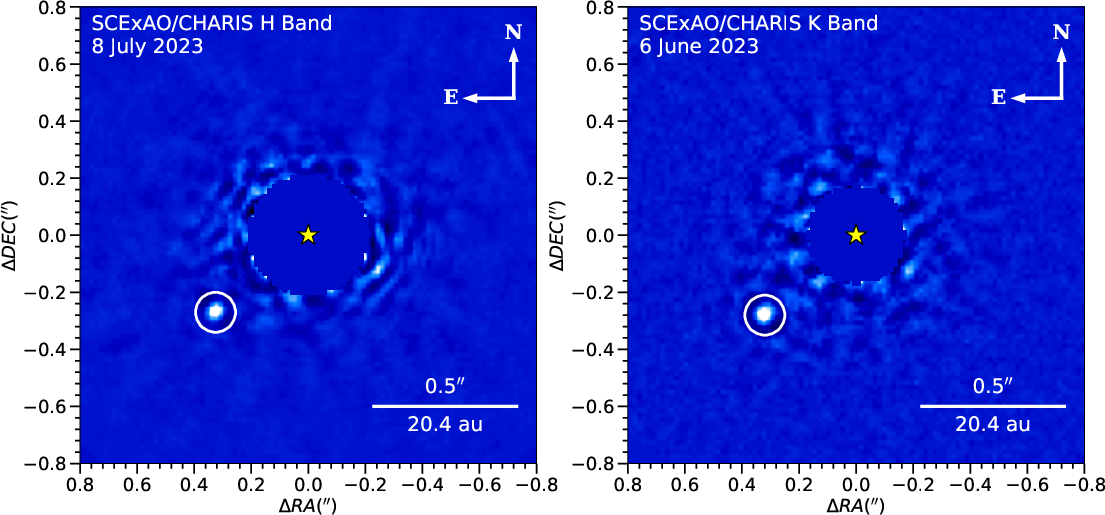
Figure 1: HIP 99770 b SCExAO/CHARIS detections in the H and K bands on 8 July 2023 and 6 June 2023 respectively. The detected companion is circled and the centroid of the star is marked by a yellow star.
The new astrometric measurements more than double the baseline for HIP 99770 b, enabling improved orbital constraints. The extracted spectra exhibit high SNR across both bands, with spectrophotometric uncertainties below 15% per channel.
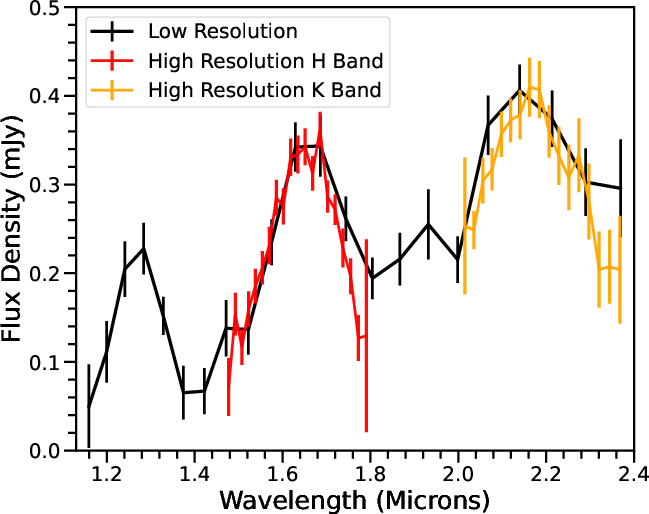
Figure 2: HIP 99770 b H band spectra in red from 8 July 2023 and K band spectra in orange from 6 June 2023 plotted overtop the low resolution spectra from the original discovery in black from 17 October 2021.
Astrometric and Dynamical Analysis
The orbital and mass parameters were derived using the orvara MCMC code, jointly fitting absolute astrometry (HGCA), relative astrometry (imaging), and a relative RV measurement from KPIC. Two prior assumptions were explored: flat and log-uniform on the companion mass.
- Flat prior: Msec=15.0−4.4+4.5MJup, a=15.8−1.0+3.1 au, e=0.29−0.15+0.12.
- Log-uniform prior: Msec=13.1−5.2+4.8MJup, a=15.7−1.0+3.5 au, e=0.28−0.16+0.13.
The inclusion of the KPIC RV measurement is the primary driver for the downward revision in mass compared to previous work. The eccentricity posterior disfavors a circular orbit, with a preference for e∼0.28−0.29. The addition of VLTI/GRAVITY astrometry further narrows the eccentricity distribution, eliminating a secondary high-eccentricity peak.
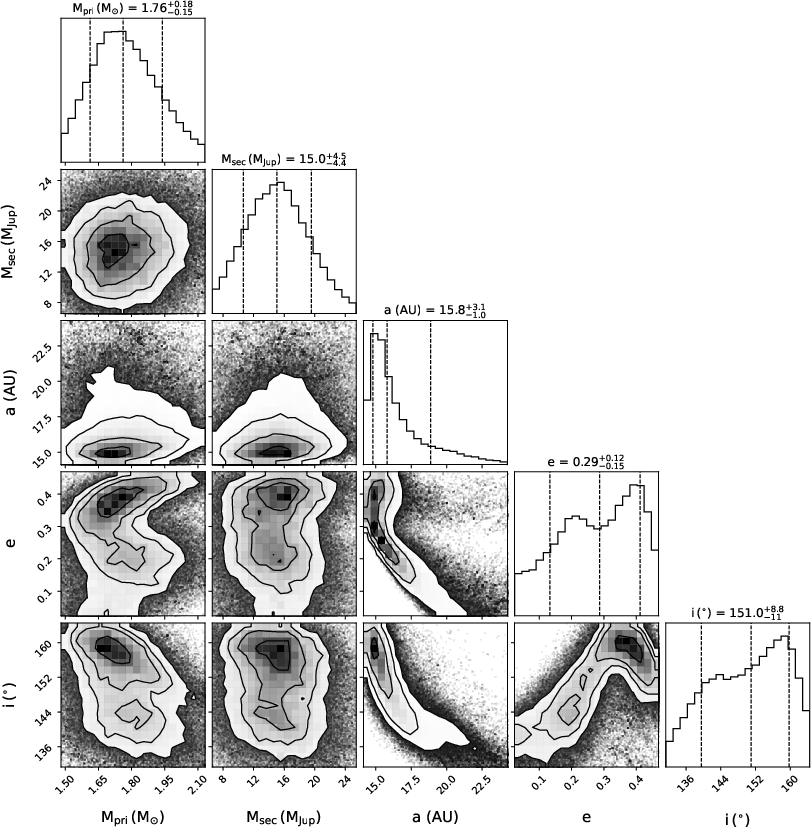
Figure 3: Corner plot showing MCMC posterior distributions for the flat prior, incorporating all astrometric and RV constraints.
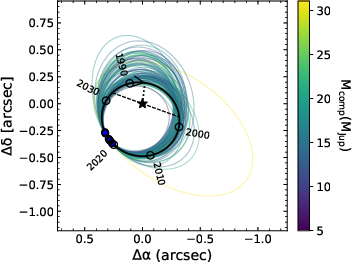
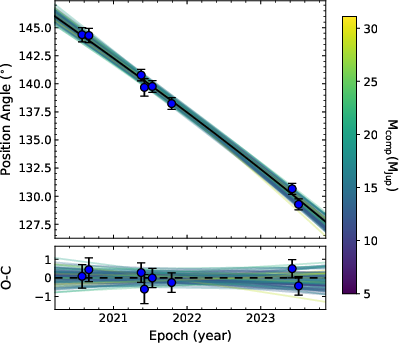
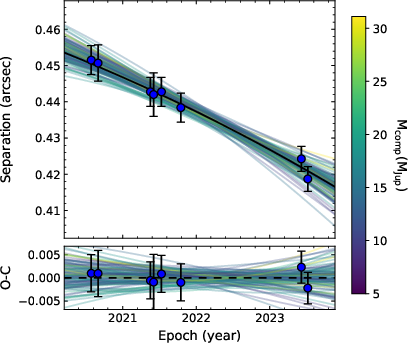
Figure 4: Orbit fitting with orvara for flat mass priors, showing the range of allowed orbits and the fit to the astrometric data.
Spectral Characterization and Atmospheric Modeling
Empirical Spectral Typing and Gravity
Comparison with the Montreal Spectral Library yields a best match to the field L9.5 dwarf SIMPJ0956-1447, with the spectral type range L6–L9.5 favored, corresponding to Teff∼1300–$1500$ K. Gravity-sensitive indices place HIP 99770 b intermediate between the low-gravity HR 8799 planets and older field brown dwarfs, consistent with its age and mass.
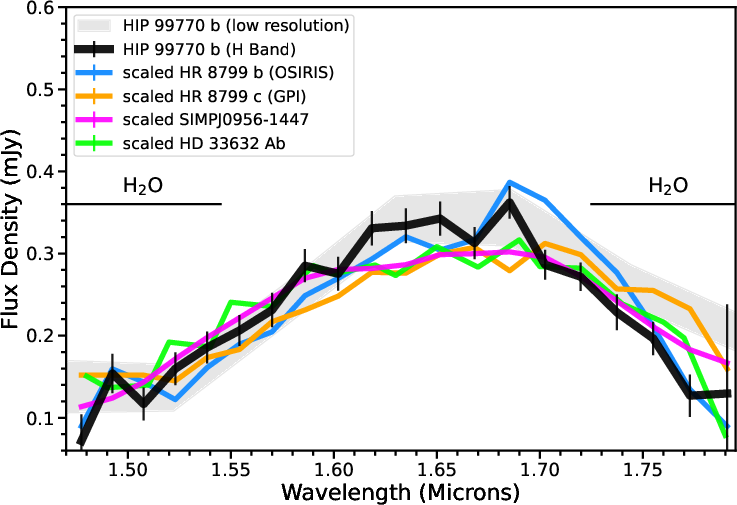
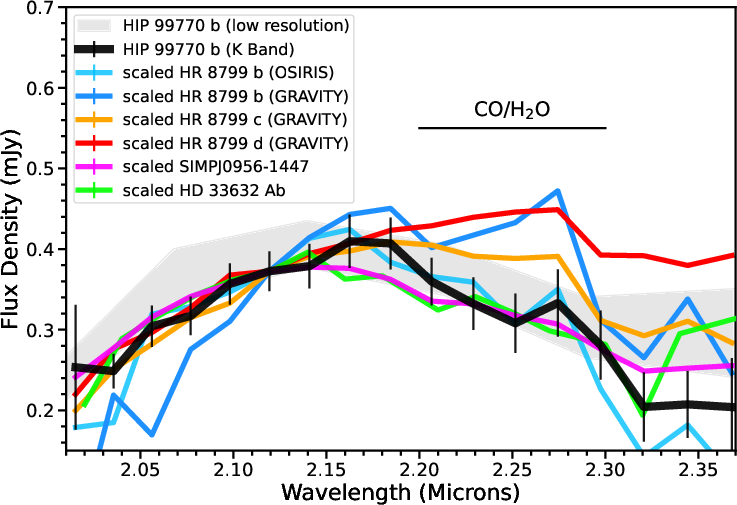
Figure 5: (Left) HIP 99770 b H band spectra compared to HR 8799 b, c, SIMPJ0956-1447, and HD 33632 Ab. (Right) K band comparison including HR 8799 d.
Atmospheric Model Fits
Four atmospheric model grids were fit to the H and K spectra and photometry: Lacy/Burrows, BT Settl, Exo-REM, and Sonora-Diamondback. All models converge on Teff∼1300–$1400$ K, with surface gravity less well constrained but generally favoring logg≲4.5. The Sonora-Diamondback model provides the best quantitative fit (χν2=1.33), with Teff=1300 K, logg=3.5, and R=1.06RJup.
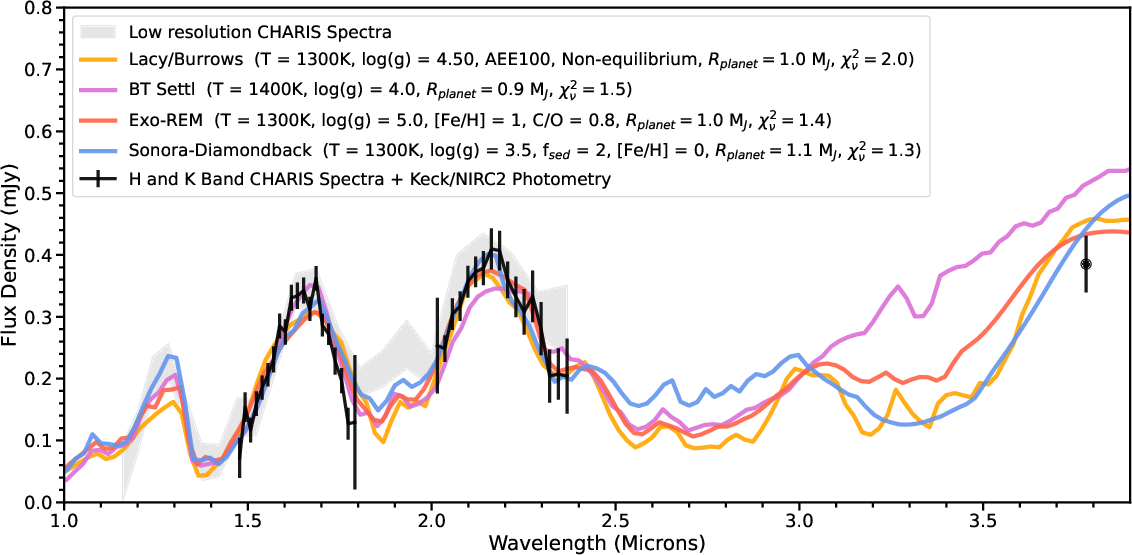
Figure 6: Best-fit atmospheric models from four grids compared to the observed H and K band spectra and photometry.
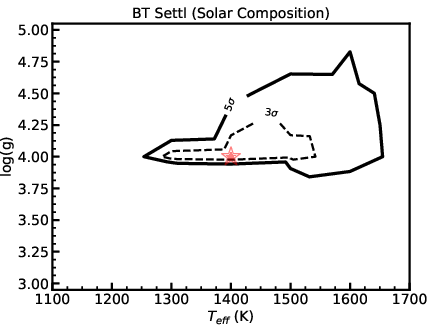
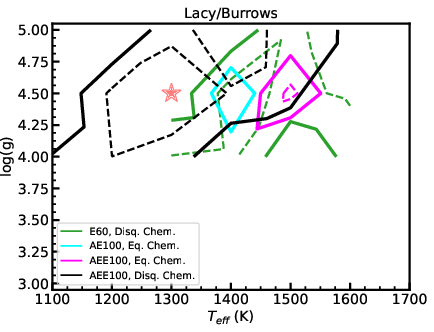
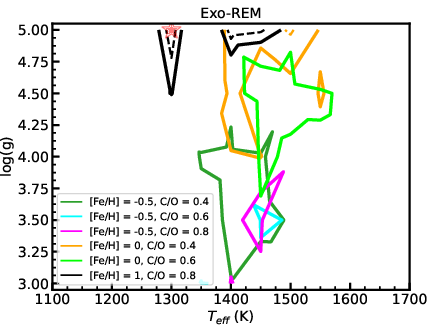
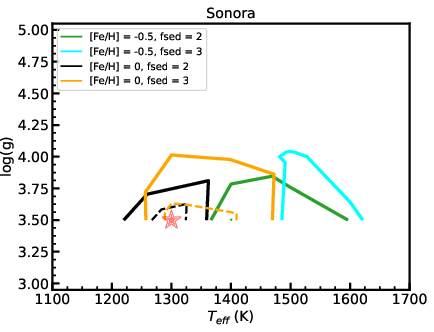
Figure 7: Δχ2 contours in Teff–logg space for the four model grids, illustrating the allowed parameter ranges.
Prospects for Future Characterization
The paper evaluates HIP 99770 b's detectability with the Roman CGI. At 575 nm, the predicted contrast is too faint for detection, but at 730 nm and 825 nm, the contrast improves to $2.9$–8.1×10−8 and $3.6$–5.7×10−7, respectively, making spectroscopic follow-up feasible in the CGI dark hole. The planet's predicted location in 2028 will be well within the CGI field of view.
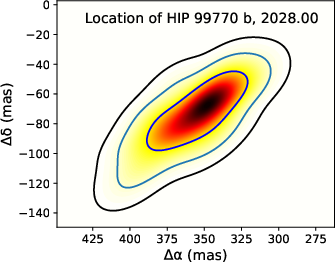
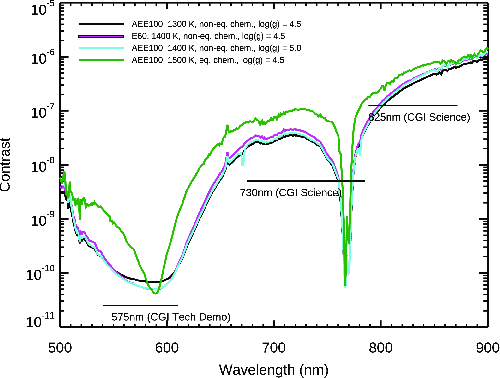
Figure 8: (Left) Predicted location of HIP 99770 b in January 2028. (Right) Predicted contrast vs. wavelength for HIP 99770 b from the best-fitting Lacy/Burrows models.
The paper also highlights the potential for JWST follow-up at 3–5 μm to probe CO, CO2, and CH4 features, which would further constrain metallicity and cloud properties.
Implications and Future Directions
This work demonstrates the power of combining high-resolution IFS, precise astrometry, and RV measurements for robust dynamical and atmospheric characterization of directly imaged exoplanets. The improved mass and orbital constraints for HIP 99770 b, particularly the downward revision of the dynamical mass due to the inclusion of the KPIC RV, underscore the importance of multi-modal data integration. The atmospheric analysis places HIP 99770 b at the L/T transition with intermediate gravity, providing a critical data point for testing substellar evolutionary and atmospheric models.
The methodology and results set a benchmark for future studies of directly imaged companions, especially as Gaia DR4 and next-generation facilities (Roman, JWST) become available. The approach is directly extensible to other systems with modest astrometric accelerations, and the synergy between high-contrast imaging, astrometry, and high-resolution spectroscopy will be central to advancing the field.
Conclusion
The multi-band spectral and astrometric characterization of HIP 99770 b refines its dynamical mass, orbital parameters, and atmospheric properties, establishing it as a key object for understanding the L/T transition and the evolution of superjovian exoplanets. The integration of SCExAO/CHARIS spectroscopy, Gaia astrometry, and RV data exemplifies the state-of-the-art in exoplanet characterization, and the system is well positioned for further paper with upcoming space-based observatories.
















